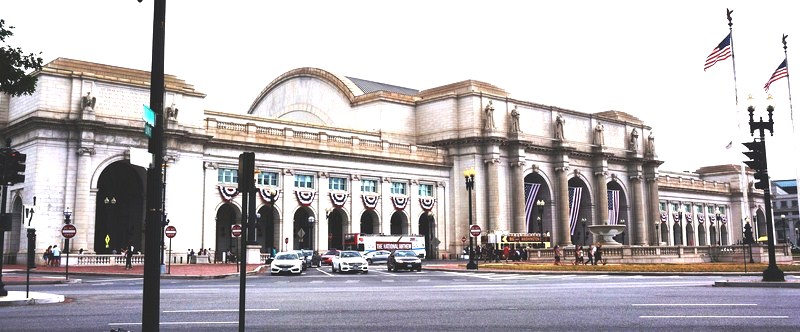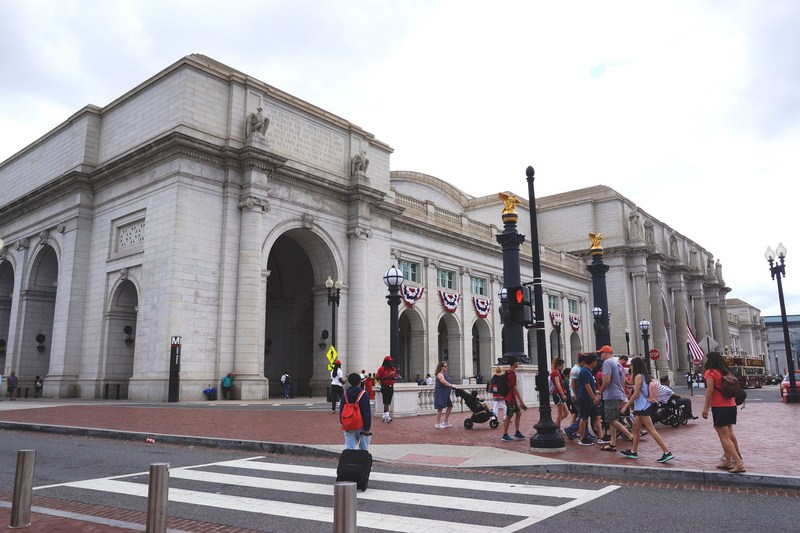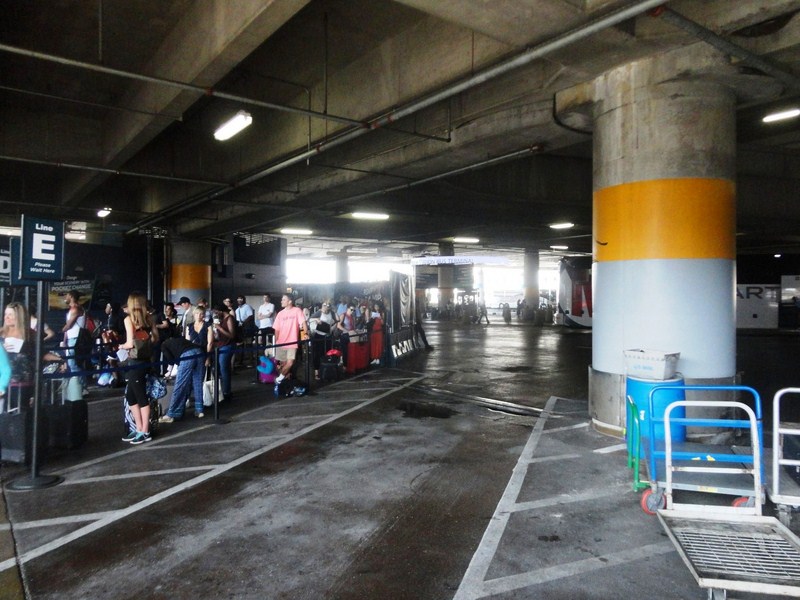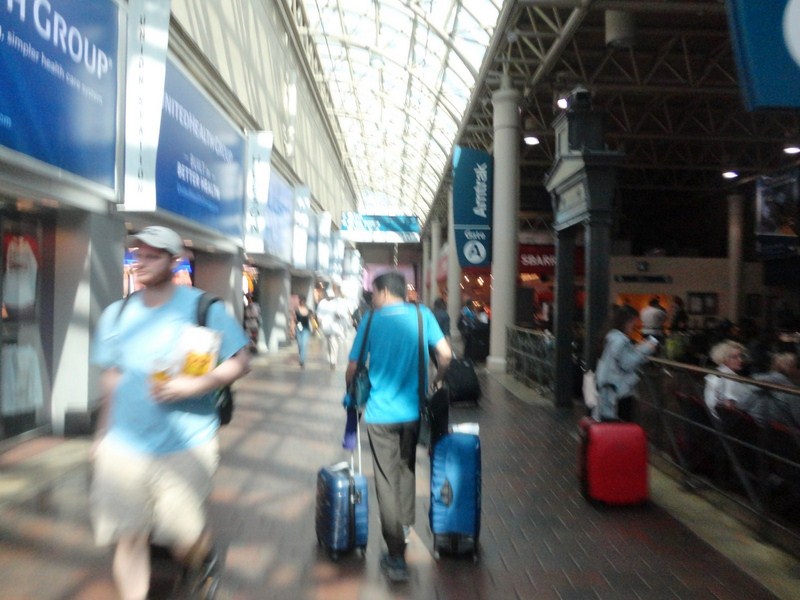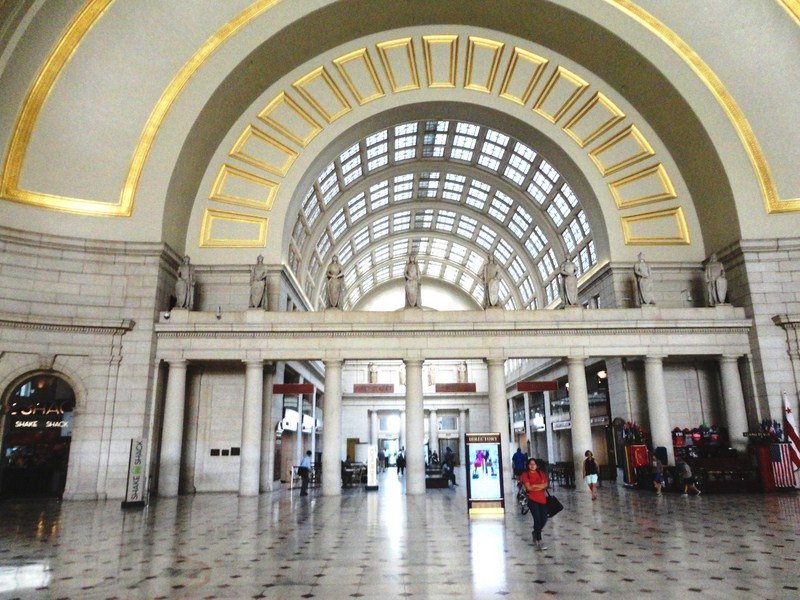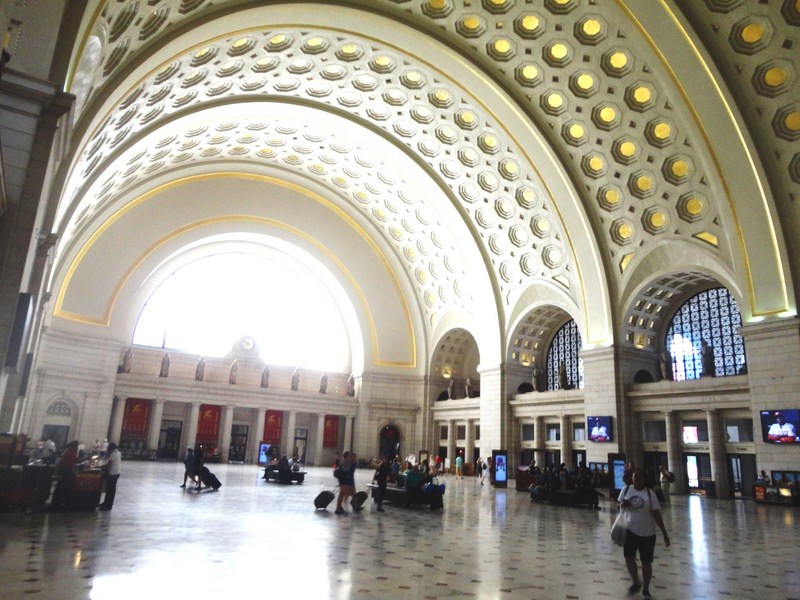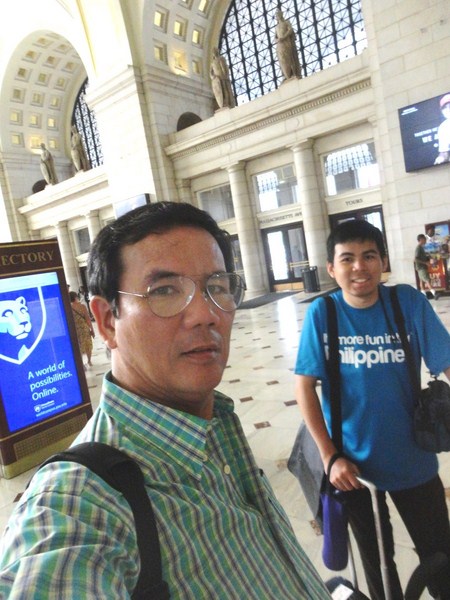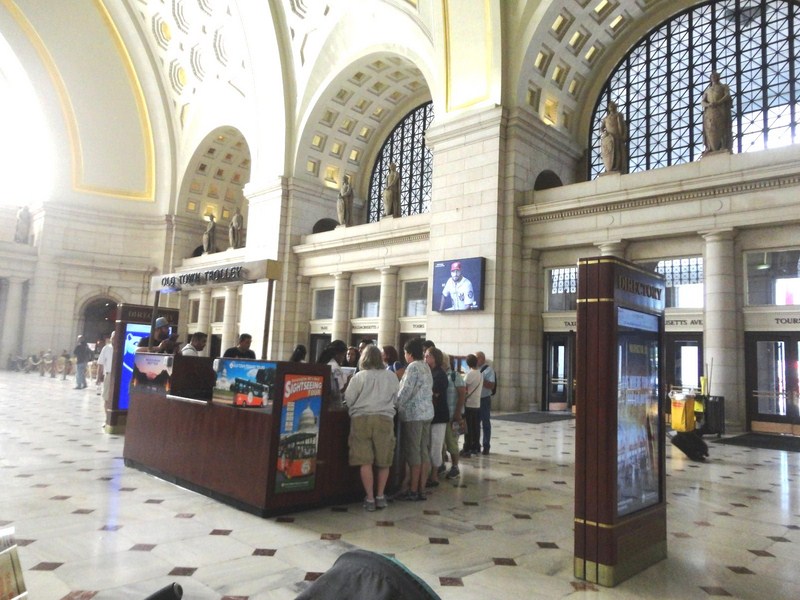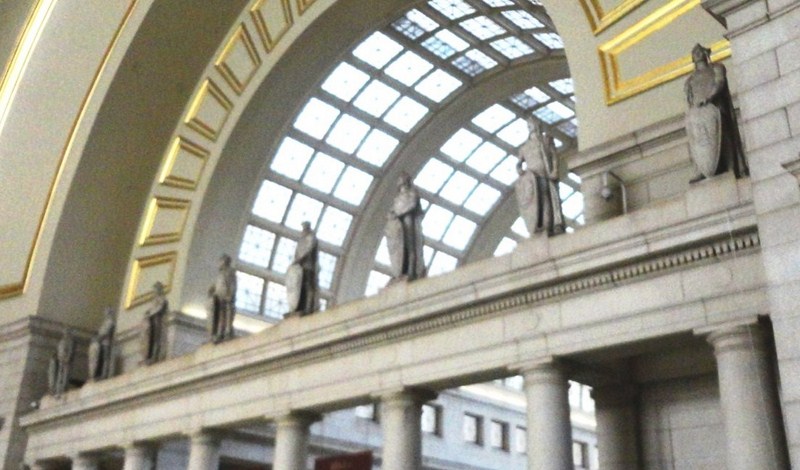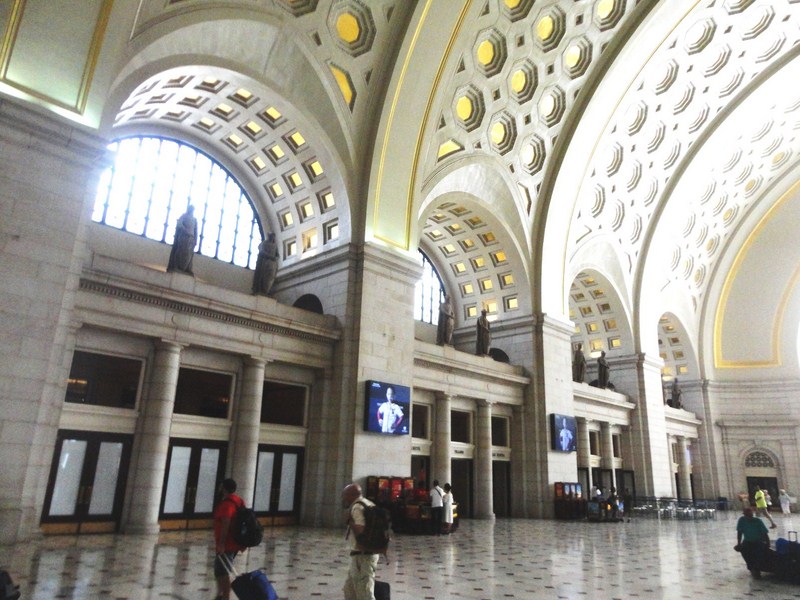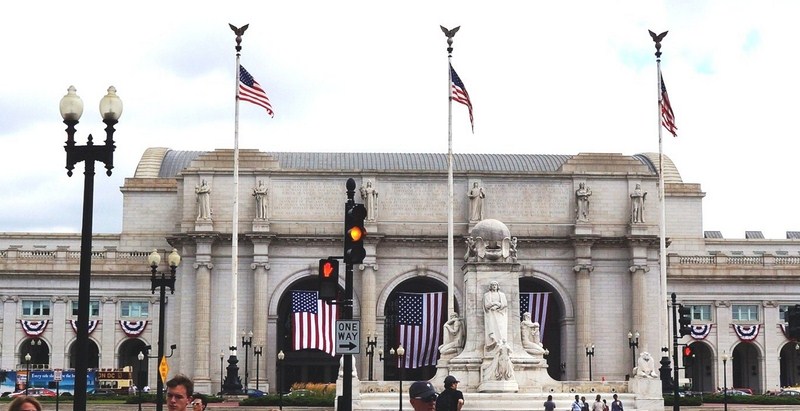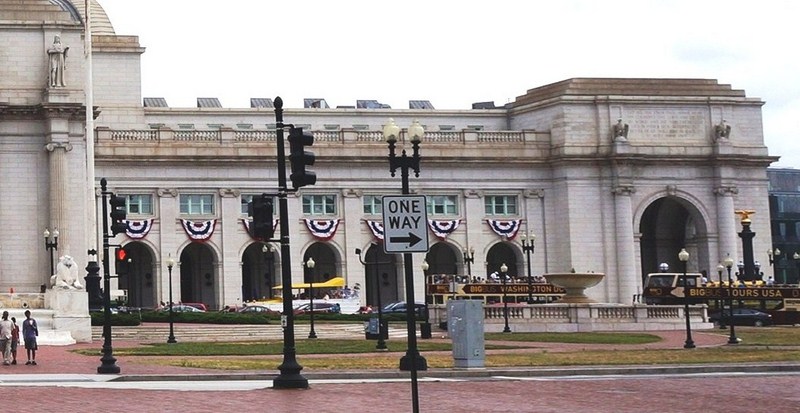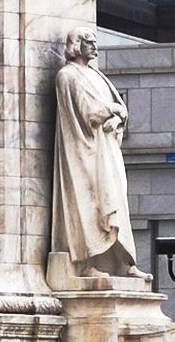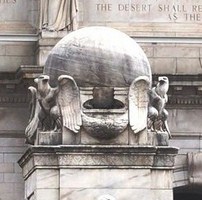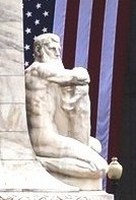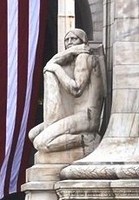The 61.62-km. (38.3-mi.) Peter Pan Bus Lines bus ride, via the MD-295 S and Baltimore-Washington Parkway, from Baltimore to Washington, D.C. took us less than an hour and we arrived at the Washington Union Station (the U.S. Capitol’s major train station and transportation hub) parking garage by 9 AM.
What awaited me when I arrived at the 183 m. (600 ft.) long main hall of the station was a soaring masterpiece done in the Neo-Classically-influenced Beaux-Arts style. Train stations are great expositions of art in public places and the Washington Union Station is one of the grandest examples of this.
The station, opened in 1907, is the only railroad station in the nation specifically authorized by the U.S. Congress. It is the southern terminus of the Northeast Corridor, an electrified rail line extending north through major cities (Baltimore, Philadelphia, New York City, and Boston) and the busiest passenger rail line in the nation.
The station is jointly owned by Amtrak (their headquarters, Amtrak owns the platforms and tracks through the Washington Terminal Company a nearly wholly owned subsidiary, with 99.9% controlling interest) and United States Department of Transportation (they own the station building itself and the surrounding parking lots). Itis Amtrak railroad’s second-busiest station (with annual ridership of just under 5 million) and the ninth-busiest in overall passengers served in the United States.
Union Station, an intermodal facility, also serves MARC and VRE commuter rail services, the Washington Metro, the DC Streetcar, intercity bus lines, and local Metrobus buses.
In 1988, a headhouse wing was added and the original station was renovated for use as a shopping mall, with many shops, cafes and restaurants (the station’s former presidential suite is also now occupied by a restaurant), making it one of the busiest shopping destinations in the United States. Today, Union Station, one of Washington DC’s busiest and best-known places, is visited by over 40 million people a year.
The building was primarily designed by William Pierce Anderson of the Chicago architectural firm of D.H. Burnham & Company. Famed architect and planner Daniel H. Burnham (the same architect who planned Baguio City), assisted by Pierce Anderson, was inspired by a number of architectural styles and Classical elements.
For the exterior and main façade, he was inspired by the Arch of Constantine (Rome, Italy) while the great vaulted spaces of the Baths of Diocletian inspired the interior.
Check out “Arch of Constantine”
The station was also built on a massive scale, with a façade stretching more than 180 m. (600 ft.) and a waiting room ceiling rising 29 m. (96 ft.) above the floor.
Stone inscriptions and allegorical sculpture were also done in the Beaux-Arts style and expensive materials such as marble, gold leaf, and white granite, from a previously unused quarry, were also used.
In the Attic block, above the main cornice of the central block, stand six, 5.5 m. (18 ft.) high colossal statues, entitled “The Progress of Railroading,” representing deities related to rail transport in the United States created by Louis St. Gaudens, modeled on the Dacian prisoners of the Arch of Constantine and cut by Andrew E. Bernasconi, a high-grade Italian stone workman, between 1909 and 1911.
Their iconography expresses the confident enthusiasm of the American Renaissance movement – Prometheus for Fire; Thales for Electricity; Themis for Freedom or Justice; Apollo for Imagination or Inspiration; Archimedes for Mechanics; and Ceres for Agriculture (the substitution of Agriculture for Commerce in a railroad station iconography vividly conveys the power of a specifically American lobbying bloc).
St. Gaudens also created the 26 centurions for the station’s main hall. Treating the entrance to a major terminal as a triumphal arch was drawn, by Burnham, upon a tradition launched with the 1837 Euston railway station in London.
The monumental end pavilions were linked with long arcades, enclosing loggias, in a long series of bays that were vaulted with the lightweight fireproof Guastavino tiles favored by American Beaux-Arts architects. The final aspect owed much to the Court of Heroes at the World’s Columbian Exposition of 1893 (where Burnham had been coordinating architect) in Chicago.
The prominent setting of Union Station’s façade at the intersection of two of Pierre (Peter) Charles L’Enfant‘s avenues (with an orientation that faced the United States Capitol just five blocks away), in a park-like green setting, is one of the few executed achievements of the City Beautiful movement, elite city planning that was based on the patte d’oie (“goosefoot”) of formal garden plans made by Baroque designers such as André Le Nôtre. Frederick Law Olmstead designed the landscape around the station.
The Columbus Fountain (also known as the Columbus Memorial), the centerpiece of Columbus Circle in front of the station, is a public artwork by American sculptor Lorado Taft unveiled on June 7, 1912. This semicircular double-basin fountain has a 13.7 m. (45 ft.) high shaft, in the center, whose front bears a full-length portrait of explorer Christopher Columbus wearing a mantle and staring forward, with his hands folded in front of him.
Beneath him is a ship prow featuring a winged figurehead that represents the observation of discovery. On top of the shaft is a globe, representing the Western hemisphere, with four eagles on each corner connected by garland.
Two male figures (an elderly man, representing the Old World, on the right, and on the left, a figure of a Native American, representing the New World) decorating the left and right sides of the shaft.
At the back of the shaft is a low-relief medallion with images of Ferdinand & Isabella. The left and right side of the fountain are guarded by two lions placed away from the base.
Washington Union Station: 50 Massachusetts Avenue NE, Washington, D.C. Coordinates: 38°53′50″N 77°00′23″W

